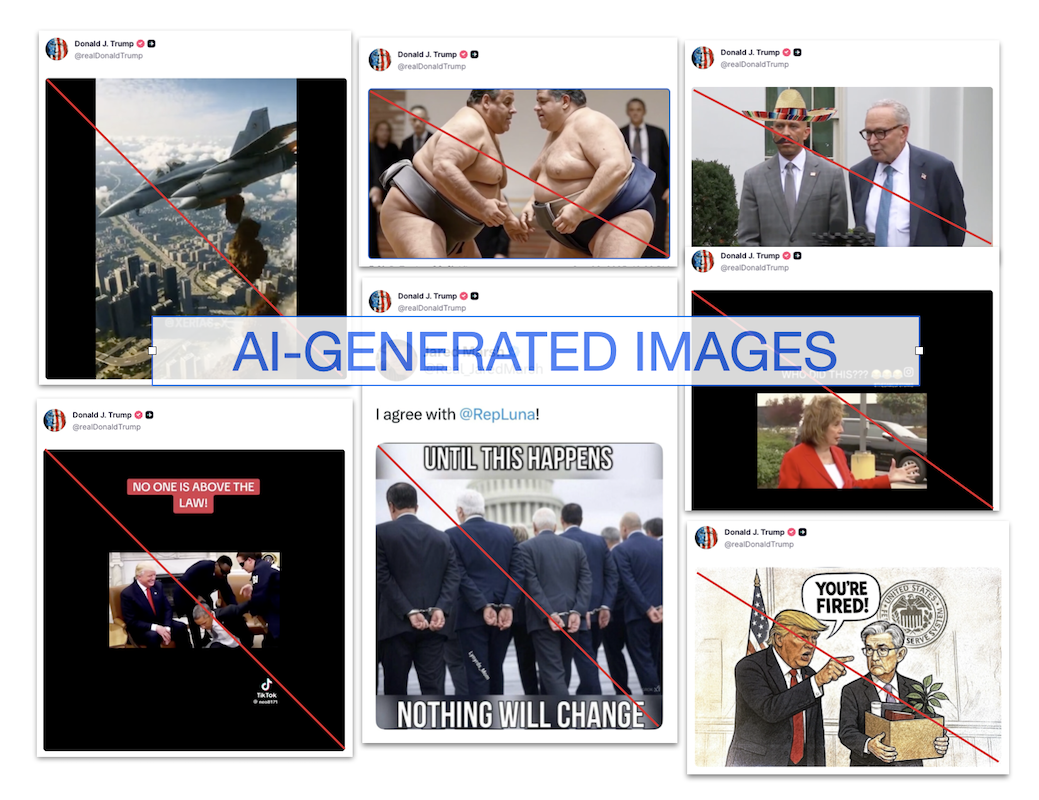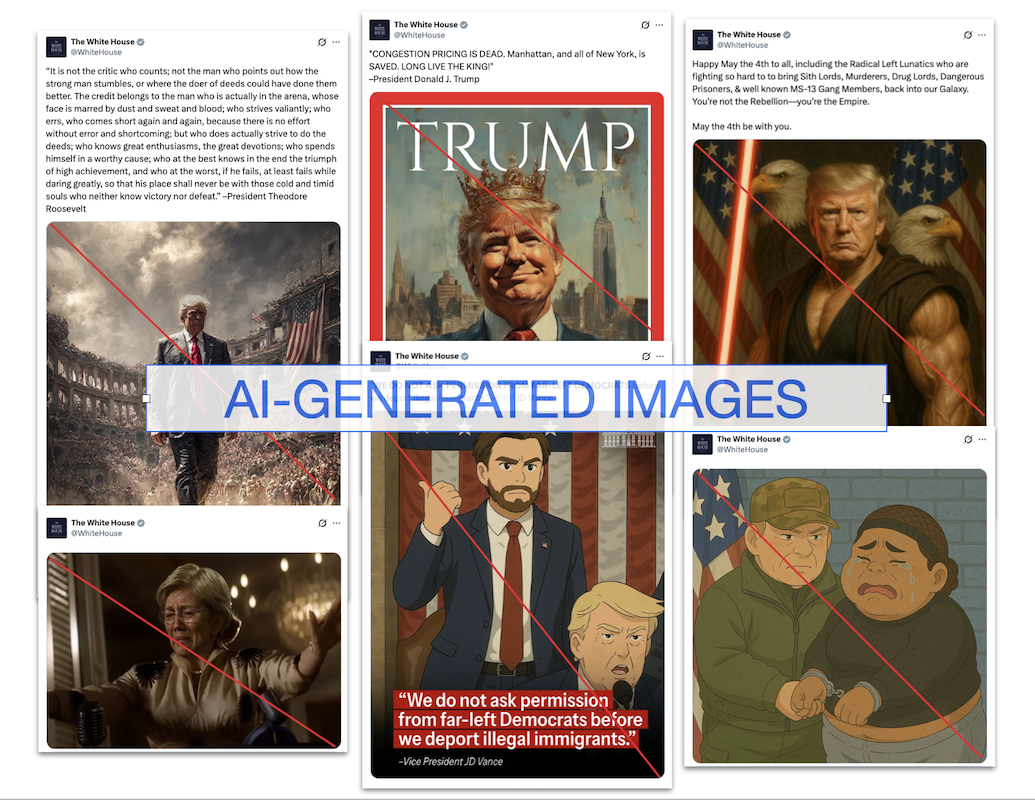On President Donald Trump’s Truth Social account, he is a king, a hero, a Nobel Peace Prize winner. His critics and political opponents are criminals, drunkards and punchlines.
Welcome to the United States’ first White House administration to embrace and use imagery generated by artificial intelligence in everyday communication.
With AI, Trump quickly deploys stereotypes and false narratives in entertaining posts that memorably distill complicated issues into their basest political talking points, regardless of factual basis.
Trump’s openness in sharing AI posts is a presidential novelty, but it tracks with how he approaches this technology. In his first term, he became the first president to issue an executive order on AI, establishing in 2019 a federal strategy for AI research and development. In his second term, he reversed his predecessor’s efforts to build guardrails around AI development and instead emphasized rapid advancement and U.S. dominance.
Since his inauguration, Trump’s Truth Social account has utilized AI in 36 posts, PolitiFact’s analysis found. Of those posts, 21 promoted or sensationalized Trump’s image and that of his administration, and 12 of them degraded his opponents. Another three reinforced his issue messaging. For example, when he was criticized for accepting a luxury jet from Qatar, his account shared an AI image of the Statue of Liberty with a sign around its neck that read “gift from a foreign nation.”
Sometimes Trump’s posts are reposts from other accounts, but in other cases, it is not clear who created the images and videos. On some occasions, Trump has said he did not create the AI images on his feed.
The White House X account, which has 2.9 million followers, has also made at least 14 posts involving AI since the start of Trump’s second term.
“While presidents have been known to distort reality in the past, there is no precedent for this regular dissemination of deepfakes from the Oval Office. This lack of concern matches President Trump’s general approach to AI — hands-off, anti-regulation,” said Katherine Ognyanova, Rutgers University associate professor of communication.
President Donald Trump’s Truth Social account uses AI most frequently to share sensationalized images of Trump as godly, powerful or tough. (Screengrabs from Truth Social)
Trump’s AI posts ramped up from the start of his second term, increasingly targeting his opponents
AI-generated posts fulfill a purpose similar to that of many of Trump’s other provocative posts: They rally his base and distract the public from other topics. But AI supercharges his messaging ability, providing hyperrealistic visuals of incidents that aren’t real.
“AI-produced content can be quite different from traditional memes, many of which were fairly low-quality images put in an easy to recognize format. Deepfakes can look indistinguishable from reality, and take considerable effort to debunk,” Ognyanova said. “Specific deepfakes can do reputational harm to the people they represent.”
In the first two months of his second term, Trump posted images that showed him roaring alongside a lion, sitting behind a table with stacks of money and conducting an orchestra at the Kennedy Center. One video envisioned “Trump Gaza,” a Gaza where money falls from the sky, high-rise resorts line a sandy shore and buildings bear his name in gold.
On Jan. 29, the president posted an image of himself with a text overlay that read “Watch the Water,” a phrase used by QAnon and COVID-19 conspiracy theorists.
Trump’s AI posts have surged since May, with his September and October posts often focused on his opponents and the government shutdown.
Trump’s most shared AI post on Truth Social since he reclaimed the White House in January was a Sept. 29 deepfake video set to mariachi music that depicted House Minority Leader Hakeem Jeffries, D-N.Y., wearing a sombrero and sporting a handlebar mustache, and Sen. Chuck Schumer, D-N.Y., saying, “Nobody likes Democrats.”
The post, reshared 19,400 times and used on X and other White House accounts, provided satirical packaging for Republicans’ false talking point that Democrats have shut the government down because they want to give “all these illegal aliens free healthcare.”
He also targeted Rep. Nancy Pelosi, D-Calif., multiple times, leaning on unproven claims that she has engaged in insider trading. “Ever since I left Congress, my trades are s—, I can’t get any insider information anymore and these f—— won’t tell me anything anymore,” one video shows her saying.
His other AI-reliant posts include a cartoon of himself telling Federal Reserve Chair Jerome Powell, “You’re fired,” a Sept. 3 video depicting Illinois Gov. JB Pritzker and former New Jersey Gov. Chris Christie as sumo wrestlers, and an image of Sen. Adam Schiff, D-Calif., in handcuffs.
In July, three days before he announced three executive orders on AI, Trump posted a video showing former President Barack Obama being dragged and handcuffed by law enforcement agents as Trump smiled on. About an hour later, he shared another showing suited men in handcuffs standing before the Capitol, their backs to the camera.
In September, Trump boosted a fake Fox News segment wherein he promoted the “medbed” conspiracy theory of a bed that cures diseases, and then later deleted it.
When a reporter asked Press Secretary Karoline Leavitt what Trump meant to communicate with that post, Leavitt said, “He likes to share memes, he likes to share videos, he likes to repost things that he sees other people post on social media as well.” She said that many times, Trump posts directly on Truth Social.
Trump’s social media accounts also employ AI videos and imagery to attack the president’s political opponents while reinforcing stereotypes and drawing on unproven claims. (Screengrabs from Truth Social)
Trump uses AI to flatter himself and his administration
The bulk of Trump’s posts glorify him or members of his administration, or sensationalize his policies. With AI, Trump is transformed into the pope and Superman.
Six days after he took office, he shared an image depicting himself on a darkened street wearing a pin-stripe suit and a fedora. A sign next to him reads, “FAFO,” an acronym that refers to the warning phrase “f— around and find out.” It was shared 14,600 times — Trump’s second-most shared Truth Social post involving AI.
On Sept. 6, he inserted himself in a spoof of the Vietnam War film “Apocalypse Now.” Text in the image read, “Chipocalypse Now,” and the caption read, “‘I love the smell of deportations in the morning…’ Chicago about to find out why it’s called the Department of WAR.”
On the second day of the government shutdown, Trump posted a video of Office of Management and Budget Director Russ Vought dressed as the Grim Reaper as Blue Oyster Cult’s “(Don’t Fear) The Reaper” played. Vought’s office had issued a memo to agencies the week prior telling them to draft reduction-in-force plans that would include permanent job cuts in the case of a shutdown.
“The videos make a splash, and if asked, the President gets to say they were simply a joke, parody, or satire,” Ognyanova said in an email.
Less than two weeks after Pope Francis died, Trump’s Truth Social and the White House X account posted an AI-made image showing Trump in papal robes and headdress. When a reporter asked him about the image and noted that it raised criticism among some Catholics, Trump rebuffed the suggestion.
“They can’t take a joke?” he said. “You don’t mean the Catholics, you mean the fake news media. Not — the Catholics loved it.”
He also said he had nothing to do with it and that somebody else made it. When the reporter questioned him using the official White House account to share the image, Trump shrugged.
“Give me a break,” he said. “Somebody did it in fun.”
When asked Oct. 20 about the video of Trump dumping feces on “No Kings” protesters, House Speaker Mike Johnson said, “The president uses social media to make a point. You can argue he’s probably the most effective person who’s ever used social media for that. He is using satire to make a point.”
The administration has defended its use of memes.
“Nowhere in the Constitution does it say we can’t post banger memes,” the White House posted July 11 on X. “The memes will continue,” it posted July 20.
On July 22, it posted a video of a golden White House and dismissed “haters” who say it’s AI.
Other government accounts such as the White House and the Department of Homeland Security have begun sharing AI images as well. The White House X account has a gray verification check reserved for government accounts. After Sen. Elizabeth Warren, D-Mass., criticized Trump’s financial support for Argentinian President Javier Milei, the White House shared a parody AI-image that showed Warren in tears, dressed like Madonna in “Evita,” the 1996 biographical film about former Argentina first lady Eva Perón.
The White House’s AI-generated posts include cartoons depicting immigrant arrests and deportations, a Time magazine-like cover of Trump in a crown under a “Long Live The King” headline, Trump dressed as a jedi and Trump walking through a dusty Roman-style arena.
The White House X account also posts AI-generated imagery boosting the president’s image, and targeting people opposing the administration. (Screengrabs from X)
At least one other head of state has taken notice of Trump’s AI-generated self-flattery.
After Trump helped facilitate a working cease-fire and peace negotiations between Israel and Hamas, the Prime Minister of Israel Benjamin Netanyahu’s X account posted an image of Trump with a Nobel Peace Prize medal around his neck, Netanyahu beside him. When Trump shared the image on his Truth Social, it garnered more than 6,000 reposts and 31,000 likes.
Trump’s embrace of AI content mirrors his AI policy
Trump has prioritized accelerating AI development, reducing efforts on regulation. One of his first executive orders during his second term revoked AI policies that “act as barriers to American AI innovation.” He has installed venture capitalist David Sacks as “AI czar,” and has hosted tech leaders at the White House.
The Trump administration’s AI Action Plan, released in July, removed Biden-era regulations that the plan called “onerous” for AI innovation. It directed agencies to contract AI technologies, particularly large language models, that are “objective and free from top-down ideological bias.”
“My Administration will use every tool at our disposal to ensure that the United States can build and maintain the largest, most powerful, and most advanced AI infrastructure anywhere on the planet,” Trump said in remarks before signing AI executive orders in July.
First lady Melania Trump has also taken the lead on the “Presidential AI Challenge,” which calls on K-12 youth and educators to develop AI-powered innovations.
But states have continued to propose legislation to rein in AI, despite Trump’s embrace of it and efforts earlier this year to impose a 10-year moratorium on state regulation of AI (efforts that Republican lawmakers are still keen on pursuing). In September, Gov. Gavin Newsom, D-Calif., signed a law that requires major AI companies to publish their safety frameworks, and allow the companies and members of the public to report critical safety incidents.
On Sept. 2, someone captured video of what looked like a person throwing a garbage bag out of a White House window. A White House official told Time Magazine it showed a contractor doing regular maintenance.
When a reporter asked Trump about the footage later the same day during an Oval Office press conference, Trump brushed it off as fake — AI, he said.
“It’s the kind of thing they do,” he said. “And one of the problems we have with AI, it’s both good and bad. If something happens really bad, just blame AI. But also they create things. You know. It works both ways.”
“If something happens, it’s really bad, maybe I’ll have to just blame AI.”
The president then marveled over a video he’d seen depicting his transformation from a baby to an adult. (Trump’s Truth Social account shared just such a video on July 4.)
“I said, who did that?” Trump said. “It was AI-generated. So, it’s a little bit scary.”
Trump has shared 15 AI posts since then.
PolitiFact Researcher Caryn Baird contributed to this report.



